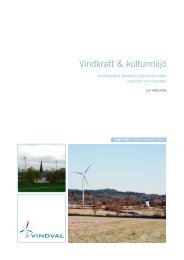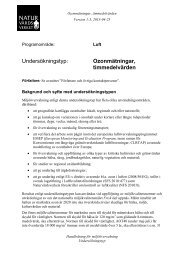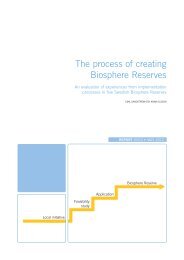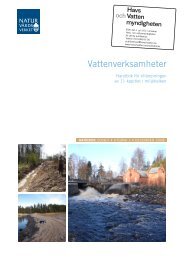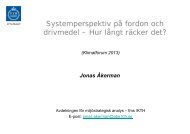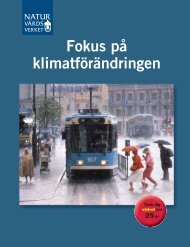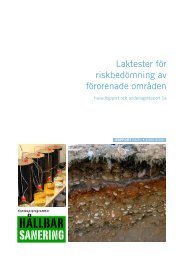Ecosystem services provided by the Baltic Sea ... - Naturvårdsverket
Ecosystem services provided by the Baltic Sea ... - Naturvårdsverket
Ecosystem services provided by the Baltic Sea ... - Naturvårdsverket
You also want an ePaper? Increase the reach of your titles
YUMPU automatically turns print PDFs into web optimized ePapers that Google loves.
SWEDISH ENVIRONMENTAL PROTECTION AGENCY<br />
Report 5873 • <strong>Ecosystem</strong> <strong>services</strong> <strong>provided</strong> <strong>by</strong> <strong>the</strong> <strong>Baltic</strong> <strong>Sea</strong> and Skagerrak<br />
Economic Marine Information<br />
Regulating ecosystem <strong>services</strong><br />
R1: Climate and atmospheric<br />
regulation<br />
Definition<br />
Chemical composition of <strong>the</strong> atmosphere and ocean is maintained through a series<br />
of biogeochemical processes. The marine environment and its living organisms are<br />
involved in <strong>the</strong> regulation of oxygen, ozone and dimethyl sulphide, as well as in <strong>the</strong><br />
exchange and regulation of carbon. In o<strong>the</strong>r words, <strong>the</strong> climate regulation taking<br />
place in <strong>the</strong> marine environment provides oxygen for breathing and slows down<br />
global warming.<br />
Extent of use and importance to society<br />
Oxygen provision<br />
From a global perspective, oceans are <strong>the</strong> largest producers of oxygen, larger than<br />
all land-based vegetation in <strong>the</strong> world. Through <strong>the</strong> process of photosyn<strong>the</strong>sis, sea<br />
weed (multi-celled sea plants) and phytoplankton (single-celled sea plants) regulate<br />
<strong>the</strong> levels of oxygen in <strong>the</strong> air we brea<strong>the</strong>. Although smaller in size than e.g. algae,<br />
phytoplankton are present in enormous quantities and so produce most of <strong>the</strong> oxygen.<br />
Carbon sequestration<br />
Human activity causes a continuously increasing concentration of green house gas<br />
in <strong>the</strong> atmosphere. These gases trap heat from solar radiation and cause heating of<br />
<strong>the</strong> planet, including our seas. Among <strong>the</strong> green house gases, CO 2 is <strong>the</strong> most significant<br />
(80 %). Current CO 2 concentration have increased dramatically during <strong>the</strong><br />
last two centuries (from 280 to 381 ppm) and are suggested to be <strong>the</strong> highest for at<br />
least 400 000 years (93). This as a result of <strong>the</strong> burning of fossil fuels (carbon from<br />
ancient sinks). According to <strong>the</strong> IPCC predictions, CO 2 concentration may reach<br />
approximately 1000 ppm within 100 years (94).<br />
Not all of <strong>the</strong> excess CO 2 emitted <strong>by</strong> human society stays in <strong>the</strong> atmosphere. The<br />
seas, and to some extent <strong>the</strong> land, act as carbon sinks that significantly slow <strong>the</strong><br />
accumulation of atmospheric CO 2 , and consequently, <strong>the</strong> resulting climate change.<br />
Roughly half of all CO 2 released <strong>by</strong> humans is now stored in <strong>the</strong> oceans (95) and it<br />
is obvious that without <strong>the</strong>se marine CO 2 sinks, <strong>the</strong> rate of global climate change<br />
would be truly catastrophic. In fact our seas store more than 10 times as much as<br />
carbon as all land-based carbon sources put toge<strong>the</strong>r. Rates of CO 2 sequestration<br />
67



